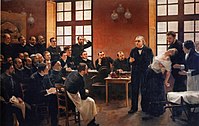
Photo from wikipedia
Abstract Objective There have been no studies comparing laparoscopic gastrojejunostomy (LGJ) and endoscopic metal stent placement (EMSP) combined with conversion therapy for gastric outlet obstruction (GOO) due to incurable advanced… Click to show full abstract
Abstract Objective There have been no studies comparing laparoscopic gastrojejunostomy (LGJ) and endoscopic metal stent placement (EMSP) combined with conversion therapy for gastric outlet obstruction (GOO) due to incurable advanced gastric cancer (GC). Therefore, the present study examined the short- and long-term outcomes and compared their therapeutic effects. Methods We retrospectively evaluated the clinical outcomes of 94 patients with GOO due to incurable advanced GC. Patients were assigned to the LGJ (n = 48) or EMSP (n = 46) groups. Multivariate analyses were conducted to identify the factors associated with overall survival. A propensity score-matched analysis was performed to avoid confounding bias. Results Compared to the EMSP group, patients in the LGJ group had fewer postoperative complications, better nutritional and inflammatory status, and a lower positive rate of tumor markers (p < .05). Conversion surgery was performed in 23 and 11 patients in the LGJ and EMSP groups, respectively. The median survival time (MST) in the LGJ group was 13.2 months, compared to 6.8 months for the EMSP group (p < .0001). Propensity score analyses confirmed this result. The MST of patients receiving conversion surgery was significantly better than that of patients without surgery in both the LGJ and EMSP groups (LGJ group: 38.3 months versus 7.6 months; EMSP group: 19.2 months versus 5.3 months, respectively, p < .0001). Multivariate analysis identified treatment selection and conversion surgery as independent prognostic factors for overall survival. Conclusion LGJ is an effective and feasible alternative to conversion therapy in terms of short- and long-term outcomes.
Journal Title: Scandinavian Journal of Gastroenterology
Year Published: 2021
Link to full text (if available)
Share on Social Media: Sign Up to like & get
recommendations!